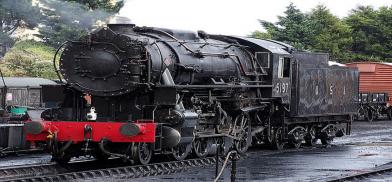A love affair with steam engines
As one grows older one remembers nostalgically the era gone by

As one grows older one remembers nostalgically the era gone by. One such era was of steam engine train travel. I would like to narrate some instances of my fascination with steam engines.
I became an engineer because of my enchantment with steam locomotives. One of my early memories (the early 1950s) is of excitedly going to Lucknow Charbagh Railway Station with my parents whenever any of our relatives came to visit us.
A mesmerizing sight
At the station, I would invariably pull my father to the location of the steam engine and stand there mesmerized with the sound of steam and the gigantic size of the engine. Early on I had also thought of becoming an engine driver since I was fascinated by his work especially when he got down from the engine to oil the steam pistons and the linkages!
Till the age of 12 years, most of my travel by train was between Lucknow and Meerut (both in Uttar Pradesh). My mother would take us to her hometown in Meerut. Whenever I traveled by train, I hardly slept since I used to constantly watch the steam locomotives and would look forward to the turns in the railway tracks so that I could watch the majestic sight of an engine pulling the train.
I was also fascinated by the different things happening in the railway yard during the shunting of our bogie. The whole hustle and bustle gave a feeling of energy and activity. Invariably sometimes looking through the open window of our compartment made the small coal particles get into the eyes. My mother would scold me and used all sorts of methods to remove them.
My best birthday presents were books on steam locomotives, and I had quite a collection of them – lovingly gifted to me by my father.
We were financially not well-off so my parents could not afford to give me the gift of a train set. Thus, any time I got a toy it was broken in no time and all the broken toys were connected together by a piece of string to form a train!
Sight and sound
I have always felt that the sight and sound of steam locomotives chugging along must have inspired lots of young kids to become engineers. There is a romance in seeing huge machines operate and the motion of moving parts with the tremendous power of steam apparently fires the imagination of young minds. I feel the present mobility systems of cars, locomotives, planes, etc., which are enclosed in sleek coverings, somehow do not do so as is done by steam engines.
This love affair with steam locomotives was interrupted when I went to the US in the early 1970s for higher studies. There we hardly traveled by train; besides the US had completely stopped using steam locomotives in their trains.
In late 1980, I came back to India to travel and explore where I would come and work. During those travels, I finally had my wish fulfilled of driving a steam engine. India like the rest of the world was phasing out steam locomotives but few routes still had them.
Childhood dream
On one leg of our journey by train, we could not get a seat reservation. So, at Kolhapur station we (my father-in-law Bon Nimbkar and my brother Alok) got into a general compartment after great difficulty and sat on our suitcases and hold-all in front of a filthy toilet! The thought of doing the journey sitting in front of the toilet was repugnant to me. So, I started looking for an excuse to get out. Suddenly I discovered that our bogie was next to the steam locomotive and I decided to try my luck.
I went to the engine driver and told him about my childhood dream to ride a steam engine. Since I was a faculty member in an American University this also helped. He agreed to take me in the engine though he was nervous since it was illegal to take a passenger in the engine. However, my convincing talk and credentials of US professorship finally prevailed upon him.
So, I rode the steam engine for one-and-a-half hours from Kolhapur to Sangli (both cities are in Maharashtra). The engine driver told me that other than the steam lever, I can touch anything. Thus, I played with the whistle/horn string, shoveled coal two times in the furnace, and talked with the driver. We had to shout since it was difficult to hear each other in the extremely noisy steam engine. Also, the cabin was hot but on December night it felt nice and cozy.
Being in the engine transported me to almost 100 years back in the history of steam locomotives in India. It seems nothing had changed! There were two gauges – one showed the steam pressure and the other the speed of the locomotive and there was a small lever for the brake. The engine was speeded up or slowed down by simply jacking up the steam lever and hanging it with a chain that was attached to the roof of the engine! There were no other controls. There was no toilet – except for one small hole in the floor in the middle of the engine!
I felt that hardly any technological changes had been brought in these engines since the late 1880s and it also reminded me very much of the state of India’s economy and affairs at that time!
When I alighted at the Sangli station, I was completely covered with soot and my clothes and body were black! Nevertheless, it was an interesting and thrilling experience.
The era of steam locomotives is gone now. Much later in the late 1990s I also had the pleasure of riding in a diesel locomotive from Valhe to Nira in Western Maharashtra (around 20 minutes journey) but somehow it was not as thrilling as the ride in the steam locomotive. The romantic era of steam engine travel is now mostly memories.
(The writer is Director, Nimbkar Agricultural Research Institute (NARI), Phaltan, Maharashtra. The views expressed are personal. He can be contacted at anilrajvanshi@gmail.com. https://www.nariphaltan.org/writings.htm)
Suggested readings:
1970s America – An Indian Student’s Journey. https://nariphaltan.org/usexpwithphotos.pdf
A life of an ordinary Indian – An Exercise in self-importance. https://nariphaltan.org/mylife.pdf










Post a Comment